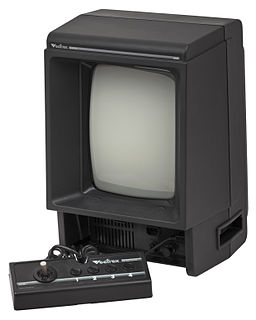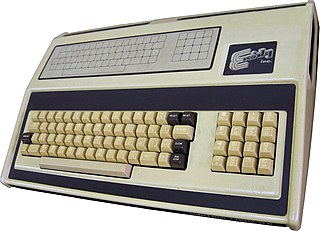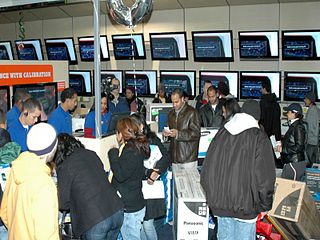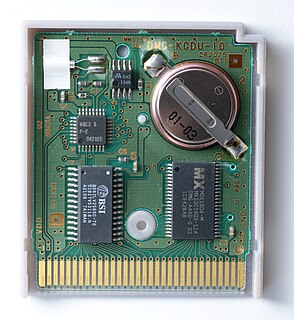
The Acorn Electron was a budget version of the BBC Micro educational/home computer introduced by Acorn Computers Ltd on 25 August 1983. It had 32 kilobytes of RAM, and its ROM includes BBC BASIC v2 along with its operating system.

The Amstrad CPC is a series of 8-bit home computers produced by Amstrad between 1984 and 1990. It was designed to compete in the mid-1980s home computer market dominated by the Commodore 64 and the Sinclair ZX Spectrum, where it successfully established itself primarily in the United Kingdom, France, Spain, and the German-speaking parts of Europe.

The Apple II is an 8-bit home computer and one of the world's first highly successful mass-produced microcomputer products. It was designed primarily by Steve Wozniak; Steve Jobs oversaw the development of Apple II's foam-molded plastic case and Rod Holt developed the switching power supply. It was introduced by Jobs and Wozniak at the 1977 West Coast Computer Faire, and marks Apple's first launch of a personal computer aimed at a consumer market—branded toward American households rather than businessmen or computer hobbyists.

The Commodore 64, also known as the C64 or the CBM 64, is an 8-bit home computer introduced in January 1982 by Commodore International. It has been listed in the Guinness World Records as the highest-selling single computer model of all time, with independent estimates placing the number sold between 12.5 and 17 million units. Volume production started in early 1982, marketing in August for US$595. Preceded by the Commodore VIC-20 and Commodore PET, the C64 took its name from its 64 kilobytes(65,536 bytes) of RAM. With support for multicolor sprites and a custom chip for waveform generation, the C64 could create superior visuals and audio compared to systems without such custom hardware.

The Intellivision is a home video game console released by Mattel Electronics in 1979. The name is a portmanteau of "intelligent television". Development began in 1977, the same year as the launch of its main competitor, the Atari 2600. In 1984, Mattel sold its video game assets to a former Mattel Electronics executive and investors, eventually becoming INTV Corporation. Game development ran from 1978 to 1990 when the Intellivision was discontinued. From 1980 to 1983, more than 3 million consoles were sold.

A video game console is an electronic device that outputs a video signal or image to display a video game that can be played with a game controller. These may be home consoles which are generally placed in a permanent location connected to a television or other display device and controlled with a separate game controller, or handheld consoles that include their own display unit and controller functions built into the unit and can be played anywhere. Hybrid consoles combine elements of both home and handheld consoles.

The Vectrex is a vector display-based home video game console–the only one ever designed and released for the home market, developed by Smith Engineering. It was first released for the North America market in November 1982 and then Europe and Japan in 1983. Originally manufactured by General Consumer Electronics, it was later licensed to Milton Bradley after they acquired the company. Bandai released the system in Japan.

The Atari 8-bit family is a series of 8-bit home computers introduced by Atari, Inc. in 1979 as the Atari 400 and Atari 800 and manufactured until 1992. All of the machines in the family are technically similar and differ primarily in packaging. They are based on the MOS Technology 6502 CPU running at 1.79 MHz, and were the first home computers designed with custom coprocessor chips. This architecture enabled graphics and sound more advanced than contemporary machines, and gaming was a major draw. First-person space combat simulator Star Raiders is considered the platform's killer app. The systems launched with plug-and-play peripherals using the Atari SIO serial bus, an early analog of USB.

The Commodore VIC-20 is an 8-bit home computer that was sold by Commodore Business Machines. The VIC-20 was announced in 1980, roughly three years after Commodore's first personal computer, the PET. The VIC-20 was the first computer of any description to sell one million units. It was described as "one of the first anti-spectatorial, non-esoteric computers by design...no longer relegated to hobbyist/enthusiasts or those with money, the computer Commodore developed was the computer of the future."

The Commodore PET is a line of personal computers produced starting in 1977 by Commodore International. A single all-in-one case combines a MOS Technology 6502 microprocessor, Commodore BASIC in read-only memory, keyboard, computer monitor, and, in early models, a cassette deck.

The Sorcerer is a home computer system released in 1978 by the video game company Exidy. Based on the Zilog Z80 and the general layout of the emerging S-100 standard, the Sorcerer was comparatively advanced when released, especially when compared to the contemporary more commercially successful Commodore PET and TRS-80. The basic design was proposed by Paul Terrell, formerly of the Byte Shop, a pioneering computer store.

Consumer electronics or home electronics are electronic equipment intended for everyday use, typically in private homes. Consumer electronics include devices used for entertainment, communications and recreation. Usually referred to as black goods due to many products being housed in black or dark casings. This term is used to distinguish them from "white goods" which are meant for housekeeping tasks, such as washing machines and refrigerators, although nowadays, these would be considered black goods, some of these being connected to the Internet. In British English, they are often called brown goods by producers and sellers. In the 2010s, this distinction is absent in large big box consumer electronics stores, which sell both entertainment, communication, and home office devices and kitchen appliances such as refrigerators.

The TI-99/4 is a home computer released in late 1979 by Texas Instruments. Based on the Texas Instruments TMS9900 microprocessor originally used in minicomputers, it was the first 16-bit home computer. The associated video display controller provides color graphics and among the best sprite support of its era. The calculator-style keyboard is a weak point, and the system suffered a lack of commercial software because of TI's requirement for ROM cartridge and only providing developer information to select third parties.

A game cartridge, usually referred to in context simply as a cartridge, cart, or card, is a replaceable part designed to be connected to a consumer electronics device such as a home computer, video game console or, to a lesser extent, electronic musical instruments. A special type of cartridge named ROM cartridge is a memory card containing ROM. ROM cartridges can be used to load and run software such as video games or other application programs.
The VideoBrain Family Computer is an 8-bit home computer manufactured by Umtech Incorporated, starting in 1977. It is based on the Fairchild Semiconductor F8 CPU. It was not a large commercial success and was discontinued from the market less than three years after its initial release. Some of its lack of success has been attributed to the decision to substitute the APL/S programming language over the then-standard BASIC. Due to the high cost of RAM memory, it only contained 1 KB. It had a full-travel keyboard, unlike some early home computers that featured membrane keypads, but with a very non-standard layout. It was designed by David Chung and Albert Yu.

The Apple Pippin is a defunct open multimedia technology platform, designed by Apple Computer, and marketed as PiPP!N. According to Apple, Pippin was directed at the home market as "an integral part of the consumer audiovisual, stereo, and television environment."

Read-only memory (ROM) is a type of non-volatile memory used in computers and other electronic devices. Data stored in ROM cannot be electronically modified after the manufacture of the memory device. Read-only memory is useful for storing software that is rarely changed during the life of the system, also known as firmware. Software applications for programmable devices can be distributed as plug-in cartridges containing ROM.

The Nintendo Entertainment System (NES) is an 8-bit third-generation home video game console produced by Nintendo. It was first released as the Family Computer (FC), commonly known as the Famicom, in 1983 in Japan. The NES, a redesigned version, was released in American test markets in October 1985, before becoming widely available in the rest of North America and other countries.

Home computers were a class of microcomputers that entered the market in 1977 and became common during the 1980s. They were marketed to consumers as affordable and accessible computers that, for the first time, were intended for the use of a single nontechnical user. These computers were a distinct market segment that typically cost much less than business, scientific or engineering-oriented computers of the time such as those running CP/M or the IBM PC, and were generally less powerful in terms of memory and expandability. However, a home computer often had better graphics and sound than contemporary business computers. Their most common uses were playing video games, but they were also regularly used for word processing, doing homework, and programming.

Nintendo 64 Game Pak is the brand name of the consumer ROM cartridge product that stores game data for the Nintendo 64, released in 1996. As with Nintendo's previous consoles, the Game Pak's design tradeoffs were intended to achieve maximal system speed and minimal base console cost—with lesser storage space and a higher unit cost per game. Integrating a CD-ROM drive, with its expensive and slow moving parts, would have drastically increased the console's base price by 50% and reduced its performance.
























